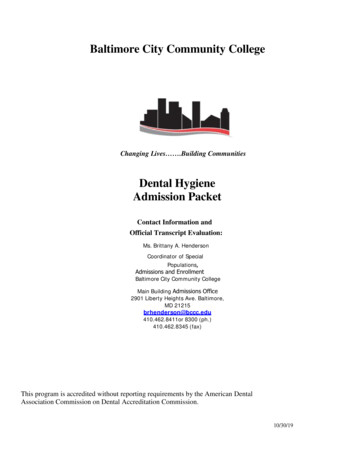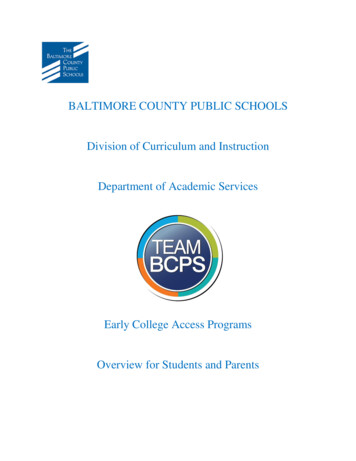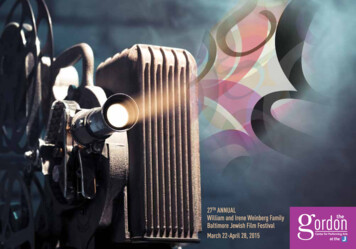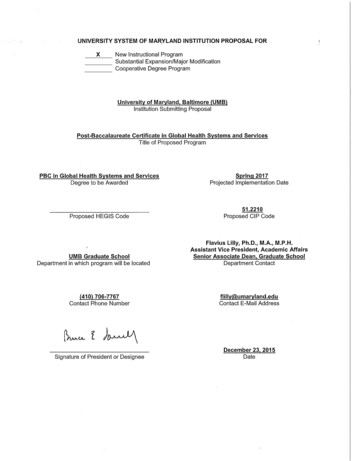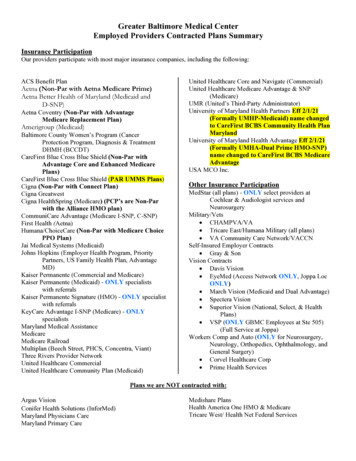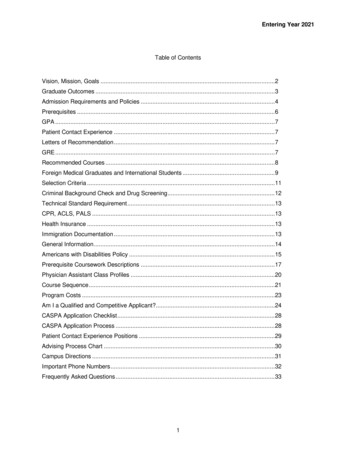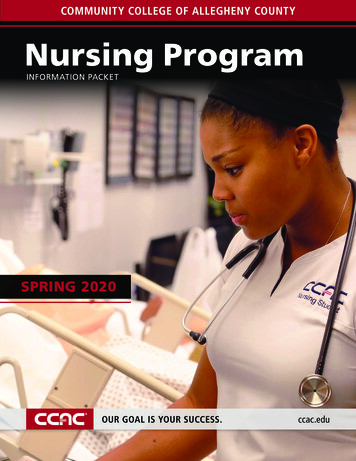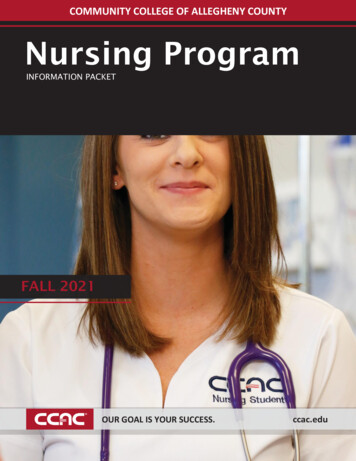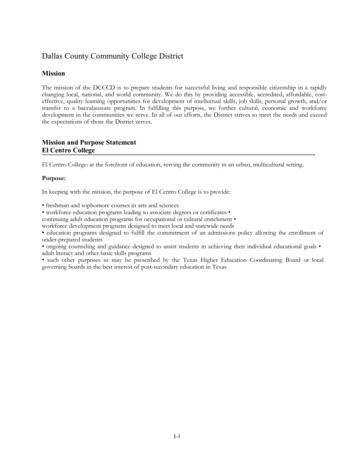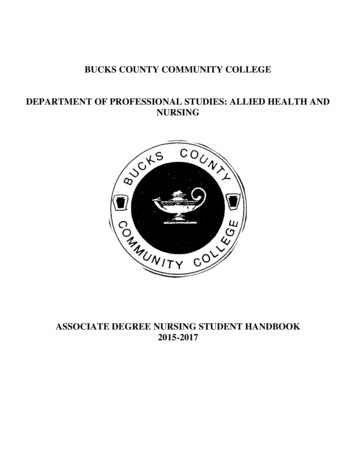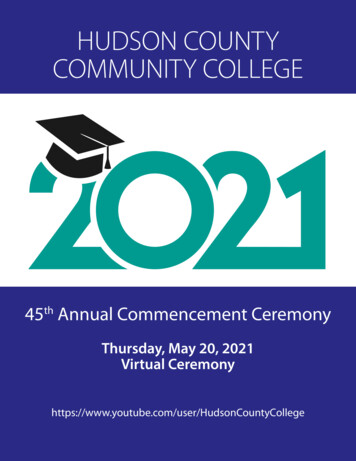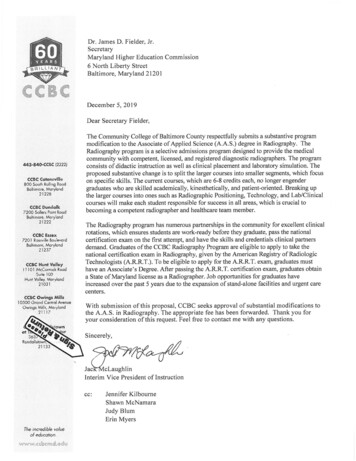
Transcription
Community College of Baltimore County-Radiography A.A.S. ProgramSubstantial Modification to an Existing Program ProposalA. Centrality to Institutional Mission and Planning Priorities:1. Provide a description of the program, including each area of concentration (if applicable),and how it relates to the institution’s approved mission.The Community College of Baltimore County’s (CCBC) Radiography program is a selectiveadmissions program in the School of Health Professions designed to provide the medicalcommunity with competent, licensed, and registered diagnostic radiographers. Theprogram runs for 22 consecutive months in all four semesters of the year: Summer, Fall,Winter, and Spring. The cohort begins in late July in the first year and finishes with theSpring semester of the second year. Two cohorts always operate at the same time. Theprogram consists of didactic instruction as well as clinical placement and laboratorysimulation. All of these occur in every RADT course, as there is only one RADT course asemester. Each RADT course is the prerequisite of the next. The proposed substantivechange is to split the larger Spring, Fall, and middle Summer courses into smaller oneswhich focus on specific skills. The current courses, which are 6-8 credits each, no longerengender graduates who are skilled academically, kinesthetically, and patient-oriented.Students can perform at below average levels in one area and barely succeed due to higherscores in another area. Breaking up the larger courses into ones such as RadiographicPositioning, Technology, and Lab/Clinical courses will make each student more responsiblefor success in all areas, which is crucial to becoming a competent radiographer andhealthcare team member.Out of the nine community college Radiography programs in Maryland, CCBC’s is the onlyone to offer didactic, clinical, and lab instruction in the same college course each semester.By splitting up the larger courses, CCBC Radiography program will be more aligned to otherradiography programs in the state.Clinical placement will now start in RADT 105, and can occur at any of the following clinicalsites: Greater Baltimore Medical Center, MedStar Franklin Square Medical Center, MedStarGood Samaritan Hospital, MedStar Harbor Hospital, Harford Memorial Hospital, UpperChesapeake Medical Center, University of Maryland Midtown Campus, University ofMaryland Saint Joseph Medical Center, and the private radiology offices of RadNet, Inc.The didactic and clinical curriculum is based on the American Society of RadiologicTechnologists (ASRT) curriculum for accredited radiography programs. This includescoursework in general education courses, such as College Composition I, Fundamentals ofCommunication, Introduction to Psychology, Principles of Human Growth and Development,Diversity in a Technological Society, and the prerequisite courses of Human Anatomy andPhysiology, Applied Algebra and Trigonometry, Fundamentals of Physics I, and MedicalTerminology. The CCBC Radiography Program is accredited by the only programmaticaccreditation agency for this field, The Joint Review Committee of Education of RadiologicTechnologists (JRCERT). The program has maintained its eight-year accreditation statussince 2014, which is the highest award given by JRCERT.1
Graduates of the CCBC Radiography Program are eligible to apply for the American Registryof Radiologic Technologists (ARRT) primary certification exam in Radiography to earn thecredentials of R.T. (R), Registered Technologist in Radiography. This certification isnecessary to obtain a license as a Radiographer in the State of Maryland. Programgraduates find employment at local clinical facilities and also may go on to study in CCBC’scertificate programs in Computed Tomography (CT) and Magnetic Resonance Imaging(MRI) and take courses in Mammography and CT or MRI Registry Review.The Radiography program supports CCBC’s mission: “The Community College of BaltimoreCounty transforms lives by providing accessible, affordable, and high-quality education thatprepares students for transfer and career success, strengthens the regional workforce, andenriches our community,” by preparing students for a successful career in medical imaging.Many radiographers who are CCBC graduates, in turn, become clinical instructors or adjunctprofessors for future students. Radiographers bring needed skills and knowledge to theregion, making our community a better place to live as medical imaging is a much-neededservice and touches almost everyone’s lives.2. Explain how the proposed program supports the institution’s strategic goals and provideevidence that affirms it is an institutional priority.The Radiography Program fully supports CCBC’s strategic goal of TransformationalAcademics in many ways:“Apply outcome-driven assessments to instructional initiatives, with the quality ofinstruction remaining paramount.” - Through programmatic accreditation, the programutilizes an Outcomes Assessment Plan, which is analyzed with a very active Advisory BoardCommittee once a year. Outcomes and trends are discussed, as well as plans and methodsfor improvement. The program uses up-to-date industry-standard curriculum, and thendelivers it with the utmost of student success in mind, utilizing many methods to reach asmany different types of learners as possible. For example, industry-standard textbooks arerequired, but then instructors incorporate lectures, hands-on activities, group criticalthinking projects, and many audio-visual aids in class. In addition, each class is recordedwith a screen-capture software and uploaded to the learning management system fromwhich students can review and study. Instructors are widely available outside of classthrough many means: office hours, Google Hangouts, and email, and respond within hours.“Bring the latest technology, techniques, and thinking from the workplace into theclassroom.” - The program maintains a high-tech radiography simulation lab, with twoenergized radiographic machines, life-size phantoms, individual bones, and other labequipment for life-like simulation. All class and lab activities are subsequently tied in withclinical performance objectives performed on actual patients to reinforce concepts, underdirect supervision. In all activities, program expectations are high for students to not onlythink critically but be able to practice their professional speaking and writing skills anddemonstrate effective patient care.“Apply local labor market analysis to drive career programming and ensure studentsacquire the knowledge and skills that meet or exceed industry standards.” - The program isdedicated to completion and successful passing of the national certification exam inRadiography. The final semester is heavily dedicated to exam review and preparation for2
job hunting and interviewing. Students attend a national seminar for exam review andpurchase an exam review software. Moreover, the program holds a mock interview daywhere clinical partners volunteer their time conducting mock interviews on the studentsand pass along helpful advice. Many clinical partners use this time to prepare students forhiring at their locations and to advertise their job opportunities.3. Provide a brief narrative of how the proposed program will be adequately funded for atleast the first five years of program implementation. (Additional related information isrequired in section L).There is no expected change in funding for the Radiography Program due to the substantivechange. The program is more than adequately funded with three full-time faculty, 10adjunct faculty, and one administrative assistant. There is a dedicated classroom whichincorporates the lab space, and the lab contains all equipment necessary to allow for lifelike simulation. Furthermore, the School of Health Professions on the Essex campus will bemoving into a new state-of-the-art building in fall 2020. The new building will have evenmore resources for students, including a Student Resource Room with computers, studyarea, and breakout rooms for tutoring or small group work. The proposed change incurriculum will not impact program funding.4. Provide a description of the institution’s a commitment to:a)ongoing administrative, financial, and technical support of the proposedprogramThe Radiography program’s current operational budget allows for the substantive change inthe fact that the School of Health Professions’ Dean has permitted the program director toreassign teaching duties to others while undergoing the change process. The program’sthree additional full-time faculty members and administrative assistant have beenproviding support to the program director in terms of giving policy advice, taking onadditional duties when necessary, and performing administrative functions. TheRadiography program held a staff meeting to address all possible issues and concernsbefore undergoing the change process. Moreover, all program members are highly skilled intechnology and use available college resources on the Microsoft Office 365 platform todisseminate and share information and documents.b)continuation of the program for a period of time sufficient to allow enrolledstudents to complete the program.The Radiography program has been approved by CCBC’s College Senate, President andBoard of Trustees; thus, adequate funding is in place for at least the next five years ofprogram implementation. The program will continue, allowing ample time for studentcompletion.B. Critical and Compelling Regional or Statewide Need as Identified in the State Plan:1. Demonstrate demand and need for the program in terms of meeting present and futureneeds of the region and the State in general based on one or more of the following:3
a)The need for the advancement and evolution of knowledgeb)Societal needs, including expanding educational opportunities and choices forminority and educationally disadvantaged students at institutions of highereducationc)The need to strengthen and expand the capacity of historically black institutions toprovide high quality and unique educational programsProvide evidence that the perceived need is consistent with the Maryland State Plan forPostsecondary Education.The CCBC Radiography Program, which has been a leader in educating medical imagingprofessionals in the area since 1973, serves a large societal need in graduating licensed,competent radiographers into the community. As the local community grows older and theelderly population and the Baltimore County population in general increases, there will bean increase in medical conditions which require medical imaging in order to aid in makingdiagnoses. Graduates from the program obtain jobs in the radiography profession in thecommunity, and then advance their careers, some in administration, some in sales, andmost in advanced imaging modalities. CCBC also provides instruction in ComputedTomography, Magnetic Image Resonance, and Mammography. Moreover, CCBC representsan affordable education for traditional and non-traditional students alike, includingminority and educationally disadvantaged students. All in all, the CCBC Radiographyprogram represents an excellent choice for many in the Baltimore region who are lookingfor a high-quality education in a shorter time than a traditional Bachelor's degree, to enter awell-paying profession that will support not only themselves, but their entire family for theremainder of their careers.The updates to our curriculum supports some of the goals in the State Plan forPostsecondary Education including providing access to a quality education, ensuringstudent success, and providing innovation in the profession:Goal 1: Access (Strategy #2: “Cultivate greater financial literacy for students and families toencourage financial planning and to prepare for postsecondary education.”) – Students inthe CCBC Radiography program are eligible for financial aid, and CCBC’s Financial Aiddepartment has many resources for students and their families, including financial aidcounseling and opportunities for tuition assistance in the form of scholarships, grants,loans, and payment plans. The Radiography program performs individual interviews priorto admission, where applicants are given an academic calendar for the 2-year program,including number of credits, and an additional expense list. This allows candidates for theprogram to plan ahead financially. Moreover, the Radiography program is almost alwayslisted on the State of Maryland’s Workforce Shortage Student Assistance Grant program list,providing in-county tuition to out-of-county students. Additionally, the School of HealthProfessions and the Radiography Program provide a few specific scholarship opportunitiesfor their students.Goal 2: Success (Strategy #7: “Enhance career advising and planning services and integratethem explicitly into academic advising and planning.”) – The CCBC Radiography Program4
provides comprehensive academic and personal support to its students. Students areafforded instructor office hours, in person and online, regular progress conferences,transcript audits, instructions on how to use DegreeWorks, and a Student Success Center toaccess tutoring and academic coaching classes on subjects, such as time management, testtaking strategies, and critical thinking. CCBC employs Success Navigators who serve asaccess points to needed critical services, whether mental or physical. Also, Radiographystudents undergo classes in resume-building and interviewing techniques in the finalsemester, but before the annual Interview Day, where the program invites clinical partnersto perform mock interviews on the students, so that the clinical partners and the soon-to-begraduates get a chance to meet one another in a less stressful environment than actualinterviews. Moreover, CCBC Radiography program students are assigned to advancedimaging modality clinical rotations in the second year, in order for the students toinvestigate possible career tracks in the future. The CCBC Radiography program alsopromotes the articulation agreements between the program and four-year partners toadvocate furthering education to Bachelor’s degrees and beyond.Goal 3: Innovation (Strategy #8: “Develop new partnerships between colleges andbusinesses to support workforce development and improve workforce readiness.”) – TheCCBC Radiography Program includes numerous partnerships in the community forexcellent clinical rotations, which ensures students are work-ready before they graduate,pass the national certification exam on the first attempt, and have the skills and credentialsclinical partners demand. Program students undergo almost 1800 hours of clinical dutyover 22 months, starting in the first semester. They are trained, starting in Orientation, thatthe program also substitutes for a 2-year long job interview, based on their conduct at localclinical facilities. Students are required to perform numerous clinical performanceobjectives in addition to competency testing, to enhance the hands-on activities of theprogram. The program maintains an active advisory committee that meets twice a year andrecommends business-driven credentialing and skill sets that are needed in the localcommunity from our graduates. In addition, the CCBC Radiography Program, with the helpof a Department of Labor grant in 2009, expanded its offerings for post-graduate study inComputed Tomography and MRI, with the development of certificate programs in each. Thedepartment has expanded again recently with the development of courses inMammography instruction. These stackable credentials allow CCBC Radiography graduatesfurther study and credentialing in advanced modalities which are very much needed bylocal business partners.C. Quantifiable and Reliable Evidence and Documentation of Market Supply and Demand inthe Region and State:1. Describe potential industry or industries, employment opportunities, and expected level ofentry (ex: mid-level management) for graduates of the proposed program.Graduates of the CCBC Radiography Program are eligible to apply to take the nationalcertification exam in Radiography, given by the American Registry of RadiologicTechnologists (ARRT). To be eligible to apply for the ARRT exam, graduates must have anAssociate Degree, and since students must fulfill all program and degree requirements inorder to graduate, graduates automatically are eligible to apply. Once passing the ARRTcertification exam, graduates obtain a State of Maryland license as a Radiographer. TheARRT certification and state licensure is necessary to obtain employment in Maryland. Job5
opportunities for graduates have increased over the past 5 years mainly due to theexpansion of stand-alone facilities and urgent care centers. Additionally, CCBC MedicalImaging offers certificate programs in Computed Tomography and MRI, and courses inMammography, representing extended pathways for stackable credentials in industrydriven options.2. Present data and analysis projecting market demand and the availability of openings in ajob market to be served by the new program.The Bureau of Labor Statistics anticipates that the occupational employment outlook forradiologic technologists, or radiographers, continue at the projected growth rate of fasterthan average at a 13% growth rate through 2026, with an increase of 30,300 new -technologists.htm . Employment in thestate of Maryland can range from working in hospitals, private Radiology offices, mobilecompanies, orthopedic or podiatry physicians’ offices, ambulatory care and/or surgicalcenters, urgent care centers, and even correctional facilities. The job outlook has increasedover the past 5 years primarily due to the rapid expansion of stand-alone surgical facilitiesand urgent care centers. Graduates are being actively recruited while they are still students,and some employers have reinstituted signing bonus processes.3. Discuss and provide evidence of market surveys that clearly provide quantifiable andreliable data on the educational and training needs and the anticipated number of vacanciesexpected over the next 5 years.Table 1 below demonstrates Maryland’s potential demand for graduates in the CCBCRadiography Program. The evidence provided is based upon the program’s proposedClassification of Program (CIP) code of 51.0907 (Medical Radiologic Tech./Technician) andcross referenced with the Bureau of Labor Statistics Standard Occupational Classifications(SOC) code of 29-2034 that classify and indicate the professions and occupations ofgraduates of programs with this CIP code are likely to pursue.Table 1: Maryland Occupational Projections 2016-2026 for the CCBC Radiography hnologistsandTechnicians471866922122881This data evidences the potential for 2881 new and additional positions in occupations thatthe CCBC Radiography Program prepares graduates over ten years, or 288 positions peryear. In reviewing regional workforce projection data, Baltimore County purports a 10.9%growth rate from 2016-2026.Maryland Occupational Projections - 2016-2026 - Workforce Information and roj/maryland.shtml6
Workforce Region Occupational Projections - Maryland Occupational Projections - 2016-2026- Workforce Information & roj/wias.shtml4. Provide data showing the current and projected supply of prospective graduates.7
Table 2: Annual Graduations from Programs in Maryland Institutions with the CIP designation 51.0907 (Radiography):School ved lege 14913813Anne echnology51-0907A911415101518Chesap
Out of the nine community college Radiography programs in Maryland, CCBC’s is the only one to offer didactic, clinical, and lab instruction in the same college course each semester. By splitting up the larger courses, CCBC Radiography program will be more aligned to other radiography programs in the state.
